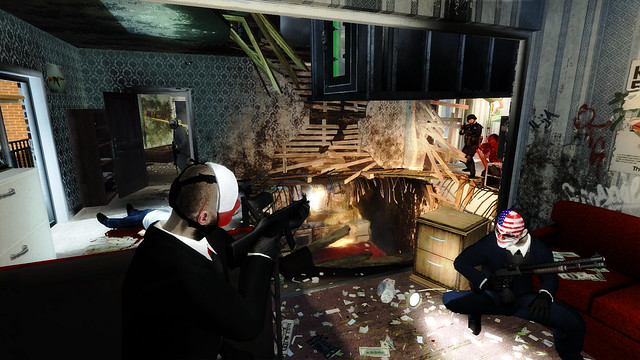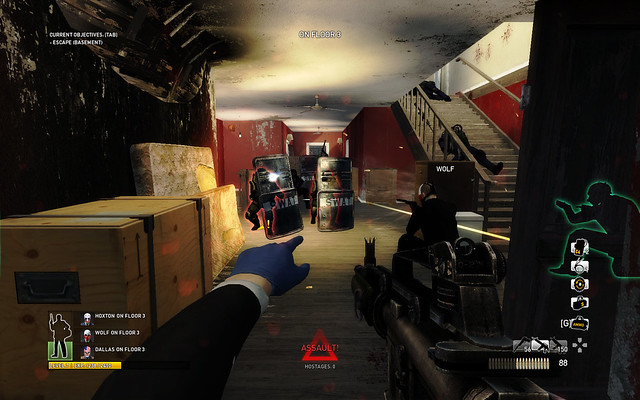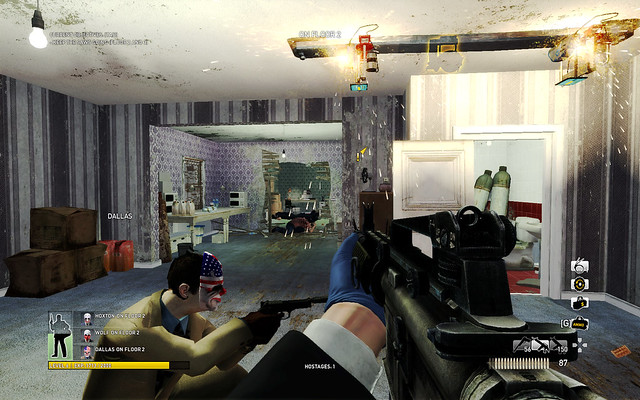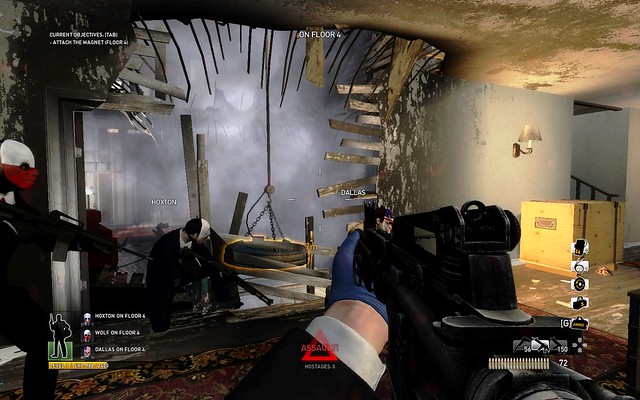
Right before E3, OVERKILL Software dropped by the Blog to debut PAYDAY: The Heist. At the time, he described it as “an action-filled first person shooter for the PlayStation Network that lets you take on the role of a hardened career criminal executing intense, dynamic heists.”
After going hands on with PAYDAY, media referred to it as “Left 4 Dead with Banks” and “My favorite discovery of E3.” With the game’s release scheduled for later this year, we had some questions of our own. Fortunately, OVERKILL obliged, with creative director Simon Viklund providing detailed answers about the game, as well as this new trailer.
PlayStation.Blog: What was the inspiration for PAYDAY: The Heist? Why was it important to focus on four-player co-op and not going the Left 4 Dead route with 4 v 4?
Simon Vicklund, OVERKILL Software: The idea came from way back – a pet project of sorts for the guys on the team. Part of what eventually caused us to start working on the project was the profound truth that Dane Cook shared when he said that “every guy wants to be part of a heist” – we realized how incredibly accurate that statement is, haha. Then of course, a lot of inspiration came from several epic Hollywood movie movies such as “Heat”, “The Dark Knight” and “Die Hard”. There’s also an ambush sequence in one of the heists that is inspired by a scene in “Clear and Present Danger” – but you get to be the guys that are doing the shooting!
PSB: Casing the bank pre-heist: Is it purely for atmospheric effect, or can you use it to your advantage in any way?
Simon: While it definitely adds to the anticipation of the heist there is of course a tactical aspect to casing the joint. The more information you can gather before letting the cat out of the bag, the better. In order to actually start the bank robbery you need to put your mask on and draw your weapon – and within a certain time from that point, the police will show up. So you’ll be “ahead of the game,” so to speak, if you have already scouted the place and know where the guards and cameras are, and where the bank manager – who you need to find – is located. Random elements make this a worthwhile approach every time you play the First World Bank Heist, and there are other heists with similar intro sequences. Other heists are even more dependent on sneaking and scouting. We have a Diamond heist where casing is even more important as you’ll be taking out alarms, avoiding laser beams and sneaking around guards.
PSB: You’ve mentioned that PAYDAY has “endless replayability.” How widely can individual heists vary? In what kinds of ways?
Simon: The objectives in the heist remain the same; the way you achieve those objectives can be different from play-through to play-through. It’s not just the pacing of the attack waves and the enemy’s entry points that change, but also things like the behavior of NPCs and their tactics. Certain people you need to locate are always found in different places, a bag of C4 dropped from a helicopter sometimes lands on the roof, sometimes in the back alley, etc. There’s a heist we call “Slaughterhouse” in which you shoot at an armored car to make it stop. Depending on when you manage to stop the armored car, its final position will differ – and that greatly effects how the rest of the scenario plays out! Another element that adds to the replayability is the statistics that measure your success during a heist: How many civilians did you kill? How fast did you complete the heist? You can decide to try to do a “clean hit” and complete the level without killing any civilians, or simply polish your completion time. On top of this there are four difficulty settings, and while your are playing the game you constantly get new weapons and toys that you make you want to try new tactics in each heist: What if I set up trip mines here? What if I put a bag of extra ammo there? The scenarios weave into the hub style level design in such complex ways that seeminly small decisions can make a great impact.
PSB: You can tie down civilians to take them out of commission — why is crowd control important? Will civilians ever attack you or impede you?
Simon: First and foremost, civilians are important to the game from a thematical perspective. If you rob a bank, there will be customers there, and that’s something you’ll have to deal with. Civilians can be an asset to you, as you can use them to trade with the police – but if you kill civilians you will be penalized.
PSB: There’s a “call out” button that you can use to communicate with your buddies and A.I.s. This is an interesting choice, why did you make it?
Simon: Civilians will panic and start running around if you don’t “remind” them that they need to stay low, and if they run around they tend to get shot – and you don’t want that. This is a great marriage between a thematical concept and a gameplay mechanic, and it also adds a sense of chaos to the experience that makes it all even more exciting. The same button can also be used to shout at police officers to try to intimidate them and make them drop their weapons, or certain character that you need to urge forward and move from point A to point B. Shouting and communicating in general is a big part of PAYDAY, so each of the four heistmen has well over 2000 phrases.
PSB: You can trade hostages to reclaim captured comrades. How does it work? Does it have a downside?
Simon: As mentioned earlier, our aim has been to incorporate all the concepts that you associate with bank robberies and heists – such as civilians, shouting and taking control over a place, and also taking hostages and trading them with the police. If you lose all your health in PAYDAY you don’t die but are rather taken into custody – and although you are automatically released after five minutes, your teammates can speed up the process by trading you for a hostage. We don’t want any stiff menus or other tedious negotiation functions that interrupt the action, so the entire trading process in the game is very streamlined. The police are only willing to trade between their assault waves, so when an assault wave is over your accomplice on the radio informs you that a trade opportunity is open. One of the hostages you’ve taken will be highlighted and your teammate will be released from custody (and respawn right beside you) as soon as you run up to that highlighted hostage and release him/her. As you understand, the civilians are sort of your “extra lives” in the game, so you want to keep them alive for possible future trade needs.

PSB: There are three main classes: Assault, sharpshooter, and support. What makes them differ in terms of tactics and behavior? Are some classes better suited to certain roles, such as crowd control?
Simon: There are actually no classes in the game – we don’t want to limit players to classes. “Assault”, “Support” and “Sharpshooter” are the categories in which we divide our upgrades – they are each a branch in the upgrade tree. If you level-up on the “Assault” branch you’ll get weapons upgrades that are suitable for an “Assault” style of playing; shotguns, more health, etc. If you level-up on the “Support” branch you’ll get stuff that’s suitable for a “Support” style of playing; machine guns, bags of extra ammo, etc. Similarly, leveling up on the “Sharpshooter” branch rewards you with the semi-automatic assault rifle, trip mines, etc. You can change from branch to branch at any point during the gameplay, and the game always shows you what the next upgrade is on each branch, so you’re pretty much picking and choosing what you want as the next upgrade. Again, the Assault/Support/Sharpshooter names are a way to categorize the upgrades *before* you acquire them, but once you actually *have* them you can mix and match as you want and aren’t limited to any class system. There are a total of 144 weapons, upgrades and perks in the game – and more will be coming in DLC!
PSB: Can you spend your earnings to enhance your character or equipment in any way, or does the cash have any long-term benefit? Can you enhance and improve your character in any way?
Simon: You character improves through the weapons, equipment and upgrades you acquire by collecting cash and leveling up on the upgrade tree. The money you collect from each heist also has a prestige value and there will be trophies connected to stealing large amounts of cash. There is a definitely a Trophy for getting a Billion dollars!
PSB: Does the grandeur of the banks increase over the six heist locations? Can you discuss the highest-level challenges?
Simon: You pick your own order in which you complete the heists – we have kind of a “party game” approach where everything is availaible from the beginning. This is because we want you to be able to play the game together with your friends no matter when they started playing the game. There is however a progression of difficulty from one heist to the next. The First World Bank and Street Heists are considered more straight-forward and are available in a an easy difficulty setting that isn’t available for the other heists. Then there are three heists that we consider to be “intermediate” in difficulty, and they are all available in the difficulty settings above “easy”. Finally, there’s the “crown jewel” in your criminal career, the centerpiece on your shelf of accomplishments: The Diamond heist – this heist is only available in the two hardest difficulty settings (“hard” and “OVERKILL”). So, you take on the heists in any order you want to, but we suggest you play the easier ones and gain some skills and gear, and then take on the harder ones later on. Or just join an experienced crew, haha.
PSB: What kinds of security systems will you encounter, and how can they thwart your mission? What’s needed to overcome them?
Simon: The foundation of the gameplay can be summed up as “outsmarting law enforcers to get the money”, so all peripheral game mechanics converge into that in one way or another – that goes for security systems as well. In the bank there are cameras, and if you take them out the SWATs won’t be able to use as many entry points as they would have if the cameras were intact. The Diamond heist has patrolling guards and laser beams that you need to stay clear of to not set off the alarm (you can complete a great part of the heist by sneaking around unseen). Doors and gates can of course also be seen as security systems, and getting through them with saws and drills takes time – during which you need to survive the constant onslaught of law enforcers. The defenders of the law make a veritable army of police officers, FBI agents, SWATs and heavy SWATs – all with their own behavior and approach to taking you down. SWATs and heavy SWATs, for example, are armored and storm in fearlessly where bank guards and regular police officers are more careful. There are also special units like the SWAT with the riot shield that you need to flank to take down, and the guy in the bomb suit with the massive shotgun who just steamrolls into any situation and just owns everybody.
PSB: What happens when you successfully complete a heist? Is there a final “getaway” sequence? Do you choose your next target?
Simon: When you reach the escape vehicle you are in the clear. Take a breather and read the stats: How much money did you collect? How many headshots did you get? How do your stats compare to the rest of the team? Then, in line with the previously mentioned “party game” approach, you are taken back to the lobby where you can of course choose to give the heist a go again. Often you level up and get new weapons in the result screen (from the cash bonuses you get) and that makes you want to play another game just to try that new weapon out – trust me, this is a game that’s hard to put away! There is always the next score… right!?!?














Comments are closed.
40 Comments
Loading More Comments